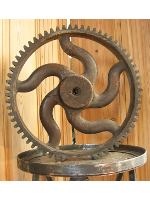This extract from The English Mechanic, 16 March 1883, was reprinted in NEWS 014, December 1993. It is now included as a classic reprint.
In the specialisation of trades once considered merely sections of the same handicraft, which has been going on during the present century, pattern-making has become a distinct occupation. Fifty years since, the old race of millwrights were “all-round” men in the engineering firms. They could fit up a mill throughout, design its arrangements, both general and in detail, make the patterns of the cast-iron work, gear the mortise wheels, chip and file the iron toothed ones, weld a shaft, turn it in the lathe, forge the levers, fit up the pedestals and bearings, and, in fact, do all the work that is now divided among half a dozen separate and distinct trades. Necessarily this meant the sacrifice of some special skill, the absence of a certain mechanical facility which results from the division of labour. But, taken as a body, they were better craftsmen, because more complete than the mechanics who now do one thing, and one thing only. They were men of a strong representative character, skilful in the use of a few rough and ready tools, and equal to contingencies as they arose. The race, except in some isolated localities, has nearly died out. Now, the pattern-maker constructs the wooden models and gears the mortise-wheels; the fitter chips, files, and fastens different parts together; the planer, slotter, and shaper save the fitter's muscles and his time; the iron-turner turns his shafts and bores his wheels; and the smith makes the forgings, and if they be somewhat heavy; he has the steam-hammer by his side.
 
|
But this division of labour has its advantages, and very great ones too. Machinery has been cheapened immensely, there is more beauty and finish about it, and it can be turned out of hand much quicker than was possible under the old regime. More and more yet, the tendency of the time is to division – specialisation of labour. Men doing one class of work alone acquire a skill, a facility in that particular branch, which can be acquired and preserved in no other way. Science and the wide fields of knowledge yield no exception to this rule. Men in any and every walk of life can only acquire great distinction by moving in one groove. The boundless universe is fair and inviting; but each must be content to plough his own little furrow, glad if he accomplish worthy work before the night comes on.
Enough of preface – now to our art and trade of pattern-making. Tools and timber, two essentials, may be disposed of briefly. Speaking generally, carpenters' tools are suitable for pattern work, but mortise-chisels are not wanted, neither is the plough and irons, nor the various bead and moulding-planes. And instead of a number of firmer chisels and gouges, long chisels and gouges, called paring-tools, are requisite. Special mention must be made of one tool – a tool which is used only by pattern makers – the "contraction-rule". As its name implies, it is a rule which is made longer than the standard measure by the amount which the metal iron contracts in cooling from the molten state to the ordinary atmospheric temperature. It would be obviously inconvenient to use a standard rule in pattern-making, because the workman would be perpetually making approximate allowances for contraction in fractional parts of a foot. So the contraction-rule economises his time and ensures something more accurate than approximations. A contraction-rule is nearly a ¼″ longer than a common 2′ rule; strictly speaking, a ¼″ in 2′6″. This represents nearly the maximum amount of contraction for iron, and is fairly correct, for general work. But an experienced pattern-maker knows that he must not trust too much to his rule, but that special allowances are required for special classes of work, and for different qualities of metal, as well as for different kinds of metal. Thus, while iron contracts an ⅛″ in 15″, brass and steel contract an ⅛″ in 10″, steel frequently rather more, and lead an e″ in 5″. A heavy casting will contract less than a light one, while a small casting will often come out as large, or even larger than the pattern. Hard iron will contract much more than soft iron, and the presence of large dried cores in the mould will diminish the amount of contraction. A plate with large superfices will almost invariably come out thicker than the pattern, owing to the fluid pressure exercised by the head of the runner, and also the top-part box not being entirely rigid. Experience alone can guide in these matters; and some element of uncertainty will always be present, for different mixtures of metal will show different contractions, as also will rapid or steady lowering of the temperature in the cooling of castings. But in general for castings of moderate size, the contraction rule is practically correct.
